By Ben A. Neiburger, Attorney, Generation Law
This post is the first installment in a series. Click here to read Part 2 of my Celtman! adventure, and here to read Part 3.
What are “Extreme Triathlons?”
They are called Xtris, for short. These races form a challenging series. The races have an “Ironman” race distance format: 2.4 mile swim, 112 mile bike, followed by a marathon. However, most Xtri swims occur in freezing lakes or oceans, the bike courses are long and extremely challenging (with substantial elevation gains — there was nearly 10,000 feet of ascent on the bike portion of the crazy race I did in 2023 – Starvation, unfavorable weather conditions, amidst stunning landscapes), and the runs are so difficult they feel like forced hikes. The Ultimate race in the Xtri series is the original extreme triathlon in Norway, called Norseman. Because of the remote location, more than 6000 athletes try by lottery (or skill) to get one of the 300 slots for participants. I was lucky enough to get a lottery spot in 2019 and deferred until I did the race in 2022. When you finish enough Xtri races, you get points you can use to get priority entry into other Xtri races. Post-Starvation, I acquired sufficient points to enter any race in the Xtri series. Opting for Norseman once more was solely driven by the desire to outperform my previous attempt. However, my heart wasn’t in it. I was doing it “just because.” When I discussed this with my triathlon coach of 10 years, Liz, she responded with sage advice: “You already did that one. Let someone else have a turn.” That sounded reasonable, so I did. I used my points to get into the second most popular Xtri, Celtman. Later, I found out that an athlete friend of mine got into Norseman by a lottery slot. I am thrilled for her, and she is positively brimming with anticipation of the race.
These races are in such remote locations that the race organizers provide only limited support for the participants. Each participant must bring his or her own support crew to collect gear, refresh food and water, and to make sure you remain alive. In addition, during the tougher parts of the run, your support person runs with you and carries survival equipment. Without your support person, you cannot complete the race. This year, I had a new support person, my 25-year-old son, Levi. Levi is not an athlete, but he agreed to train up to accompany me during the back end of the marathon, which would either be a climb up a Munro (Scottish mountain) or a long trek along the “low course” around that mountain. I think this could be his last athletic adventure.
Preparation and Luck
Preparing for a race like this takes a lot to be successful. That means consistent training, nutrition, avoiding injury, and making sure the rest of your life goes on despite the heavy mental and physical load from the training. With work pressures, it’s a crucible. You strive to be something harder, not just carbon that disintegrates to the touch.
I would say the preparation was consistent and heavy for how my life is – running a law firm and keeping social ties going. The training loads ranged from 9 hours per week to 16 hours per week, which is a lot given the other demands in my life. I understand athletes can dedicate more training time to their triathlon hobbies, but I did my best. The weekend workouts got quite long, included three hour runs, and many weekends with a bike training session that took between 6 and 8 hours to complete. With that type of training load, I could do nothing but work, plan the race, and sleep (or walk around in a tired zombie like state on the weekends). It’s something you can do for a couple months, but it gets old when you are missing a lot of life for a selfish athletic pursuit.
Last year, I completed an extreme triathlon called Starvation. This triathlon had the toughest bike course I’d ever experienced (including a climb late in the race that I could not do—I had to hop off the bike and walk part of it), and a trail run and rock scramble at an average elevation of 9000 feet. Out of the 64 who started the race, only 26, myself included, could complete it. I doubted the existence of races more challenging than that. Since I had finished that race and two other grueling triathlons in Norway and Chile, I thought I could finish this one. Well, they say you are always learning and sometimes hubris has a way of backfiring on you.
I have always relished tackling tough challenges and reaping the fruits of my efforts. It’s even better when you can do things others cannot do. I guess it’s an insecurity validating mechanism, but it harms no one and you have an adventure too. Long course extreme triathlon completes that process for me. Working through three sports, my inability to starve myself to be a fast skinny person, and trying to remain sane while not shutting down the rest of my life.
Completing a big race takes planning and luck. Not only do you need to make your body ready, but all the logistics must work too. You must arrange race gear, supplies, nutrition, travel (make sure your bike arrives on the airplane), rental car, lodging, and that everyone stays healthy enough to take part. An unlimited amount of “life happens” events have the potential to disrupt a race. So, you try to be very careful while training (to avoid injury), logistics (I had a 7 page supply list broken down into sections of the race and stuffed in different packing cubes. Examples include: swim, transition 1 (bike gear), cold bike bag (extra gear for rain or low temperatures), transition 2 (running), mountain gear, and nutrition.), and keeping everyone healthy.
You must get lodging the minute you get your race entry spot after the lottery, since the local infrastructure can only house so many people. The limited lodging availability fills up quickly. For example, the closest location to the race was our gorgeous Airbnb, a one hour drive from the race start. We booked it only two days after the organizers announced the race entry lottery results.
I spent the two months before the trip training, packing the bags, worrying about booking transportation, and complaining about having a mental block finding lodging in Scotland for after the race. My wife, Barbara, stepped in and took care of the lodging with a couple of hours of internet work. In addition, we made this trip into a family trip. It would be me, Barbara, and our two adult sons: Drew (21) and Levi (25). This was our first international trip as a family and would be very special. The logistical challenge was finding a vehicle for rent that was large enough to carry four adults, their luggage, and all of my triathlon gear (including an assembled bicycle). In addition, we encouraged the children to travel to the UK and Europe. So, after the race, we all would go in different directions. The solution was renting two rental cars. Even though the cost doubled, it remained a practical decision. Levi and I had to travel between the race course and various race meetings. While we did that, Barbara and Drew could pursue their own activities on their own time schedules, miles and miles away from wherever Levi and I would be. So, I made two reservations, one shorter, so the children could return the rental car to the Glasgow airport on their way to their travels and a longer booking for Barbara and me to tour northern Scotland after the race.
From Chicago to the Scottish Highlands
Travel to Scotland was uneventful, other than my frenzied packing and trying to get the last bit of office work done. We booked flights on Iceland air (opting for a brief stay in Iceland on the way home). I’ve taken Iceland air to Europe several times with a bicycle in luggage, and it always goes smoothly for me with short and efficient stopovers in Reykjavik to change planes. We arrived on time in Glasgow and stayed for a couple days downtown (in case the airlines delayed my bike bag arrival) before picking up rental cars and driving five hours to get to the Western Scottish coast.
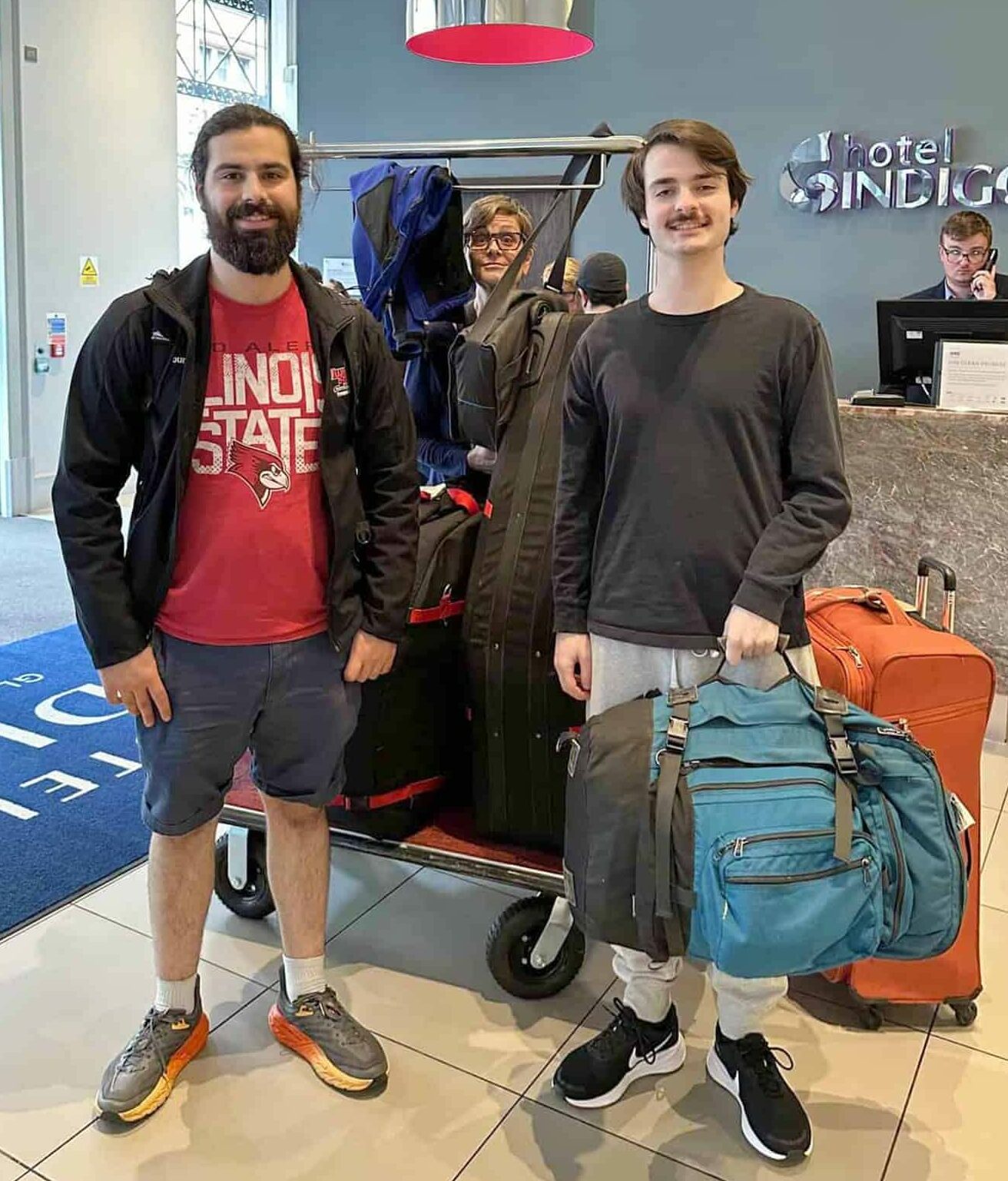
Levi, Barbara, and Levi with all of the triathlon luggage in Glasgow.
Glasgow is lovely.
We arrived in Glasgow on Monday and left on Wednesday. We got free upgrades on the cars and opted for the £41 per day extra car insurance. In addition, I learned that one person cannot rent two cars, so we switched one rental to my son and kept the other for me.
The drive to our Airbnb in Gairloch was uneventful, with a stop at a pub in Inverness for lunch. The Airbnb location is in the woods up a winding slope with a gravel driveway you need to back into while navigating a fence. The car must face downhill to back into driveway due to the tight turn from the gravel road. You also needed to open a gate at the same time. The car ballet proved to be challenging, exacerbated by rental cars equipped with beeping and squawking noisemakers to alert proximity to objects. With the limitation of one car exiting the driveway at a time, there was extensive car rearranging. Being early in our trip, we were up to the challenge, but wishing we could turn every warning sound the cars made off (a warning sound squawked while backing up; another bleated when the back of the car or the front of the car got too close to something; and the car pinged when the sides of the car approached too closely to something). So, navigating tight corners in an enclosed driveway was an affair.
Celtman Locale
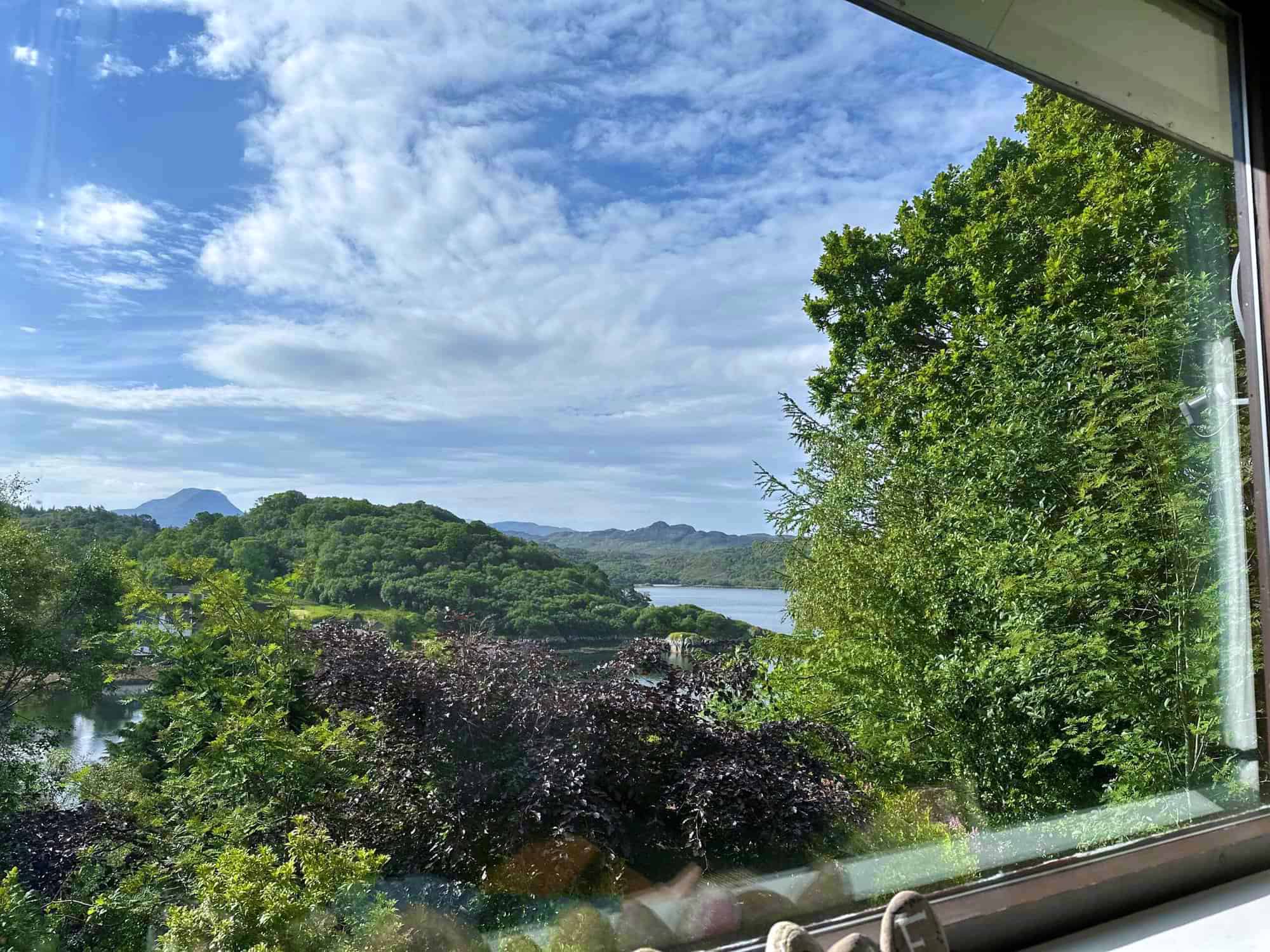
Amazing view from our Airbnb.
Celtman takes place in the Central Wester Ross area of the Scottish Highlands. The Highlands have a rugged, beautiful coastline, lush greenery, and weather. You are never without the prospect of wind and rain and cold. The area is teeming with plentiful flora and fauna, including whales and jellyfish in the cold waters. The locals are very delightful full of a dry wry sense of humor.
According to Wikapedia, “Wester Ross has one of the lowest population densities in Europe, with just 1.6 people per km2, who live mostly in small crofting townships along the coastline of the region. The area is renowned for the scenic splendor of its mountains and coastline, and the range of wildlife that can be seen. It is a popular tourist destination, receiving around 70,000 visitors each year. Tourism forms a major part of the economic activity of the area, accounting for 35% of all employment. Other major economic activities in the area include commercial fishing, renewable energy, agriculture and fish farming”
The swim course starts at a special place called “Sheep Shit Field” in a small village, Inverbain. The participants swim across the cold loch to Shieldaig Village, change and jump onto bicycles for a 125 mile tour, and then run an extremely challenging multi-surface gauntlet of a marathon.
Course Preview and Race Registration
On Thursday, Levi and I left the Airbnb to go drive the bike course. I’ve learned from prior races that knowing the course ahead of time helps minimize surprises later and reduces athlete and supporter stress. In addition, spending time with your twenty-something adult child is even more valuable (especially when he gets to see how his old man can endure suffering). We had a fun afternoon driving the 125 miles and seeing course’s beauty. It is world class sightseeing and shouldn’t be missed.
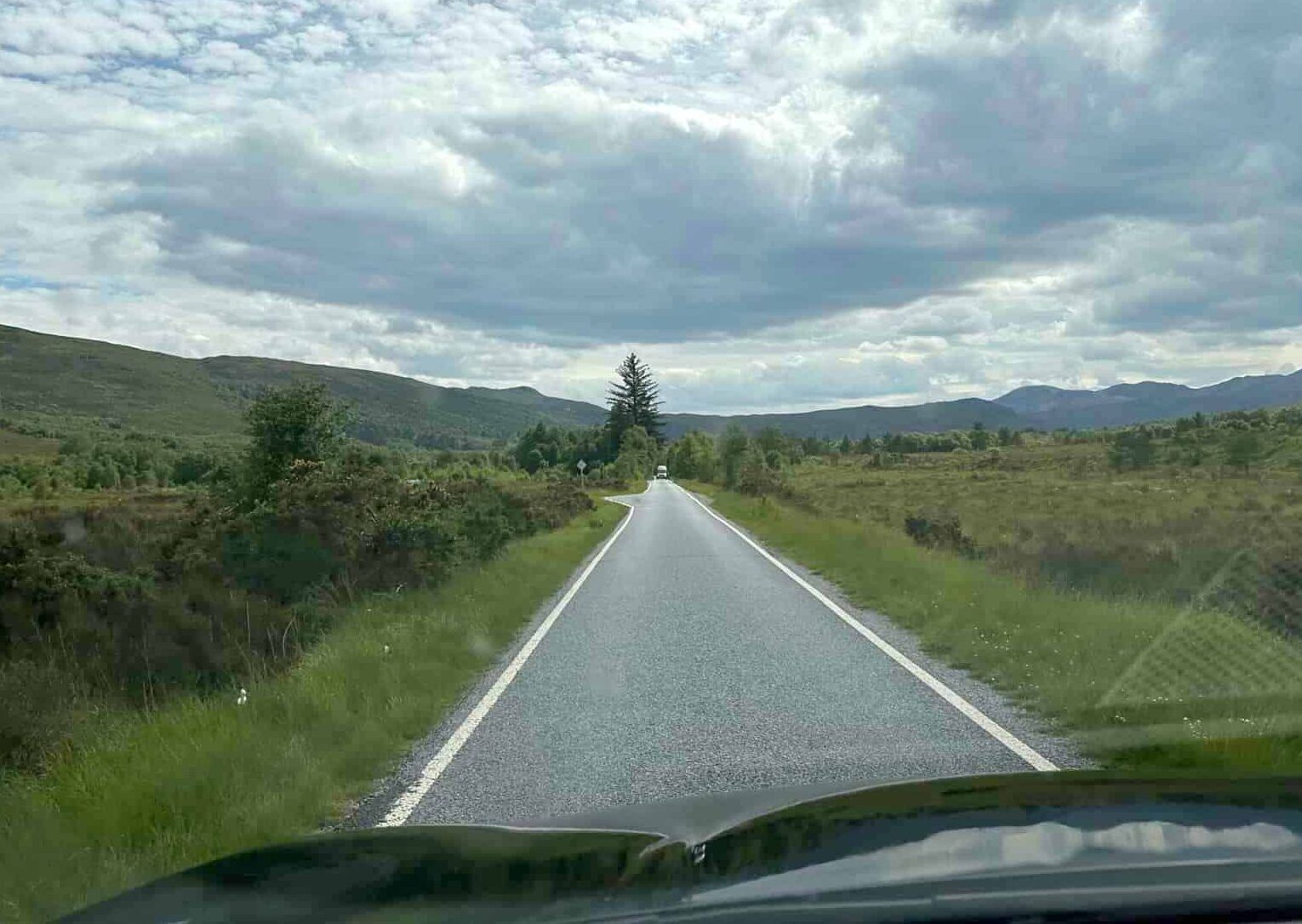
The single track road up Torridon Valley
Following the course tour, we drove to Torridon Village for race registration. From the main road at Kinlochewe (pronounced kin lock you), Torridon Village is 10 miles down a single track paved road. While I’ve done single track bicycle trail riding, I’ve never experienced what that is in a car. A single track road is a one lane road with little bump outs every tenth of a mile or so with a sign reading “Passing Place”. When two cars going in opposite directions meet, one pulls into a passing place and the other drives by. It’s a fun exercise in being overly polite to fellow drivers. It becomes a more intricate dance if you are in a small caravan of two, three, or four cars. As you travel more in the remote country, the roads switch between single track and double track to keep you alert and alive.

I think they take these pictures so they can identify you during search and rescue operations.
The Thursday night registration at the Torridon Village Community Hall was quick and efficient. Race staff checked our “mountain bags” to make sure we had all the equipment necessary if we became stranded on the mountain. Athletes who reach the first run checkpoint after the second transition (Bike to Run – T2) within 11 hours of the start of the race, can climb the “high course” up 1100 meters of Beinn Eighe and along its ridge. Sometimes the weather on the mountain can turn nasty, so our mountain kits needed a map, compass, headlight and emergency kit (foil blankets and first aid). The other key run time cut off was to get to T2A by 13 hours to go on the low course, or your race is over (for safety).
We left registration after shopping in the race store (I bought coffee cup and passed on the branded hoodies, bike kits, and hats). After our one hour drive home in the rain, the family went out for a nice dinner in Gairloch.
On Friday, I had to make two trips to the race site (two hours each round trip). The Village Shieldaig pier, located another 7 miles past Village Torridon, hosted a practice swim at 9 am, while a race briefing took place in Village Torridon at 4 pm.
Because the water was cold, I wanted to make sure to test all my swimming gear and get a feel for the temperature so that I wouldn’t be shocked on race day. At 9am, a group clad in wetsuits, gloves, warming vests (an extra neoprene layer over the torso), booties, caps, goggles, and hoods assembled. Then you marched down a long concrete platform into the cold depths.

Swim Practice. Doesn’t that wetsuit look slimming?
The moment I put my body in the 53-degree water, I knew I did the right thing taking part in this practice swim. Despite all my preparation, the water felt too cold on my face. Panic inducing. Then my goggles leaked. The temperature was frigid. Skin was not turning numb. Shit. Then I took a couple of deep breaths and shut off the dialog in my head. I moved back to the ramp, adjusted my goggles and by that time my face became nicely numb and stopped hurting. Once I was back in the water, I started swimming towards the practice buoy. I wondered where the infamous jellyfish would show up, but not there. The successful trial swim boosted my confidence for the next day’s swim. I stopped at the coffee shop in town to be social, but only waited 50 minutes for a good cup of coffee and left. I returned to Airbnb in Gairloch at noon, had lunch with family. Levi was getting sick, so I told untrained Drew that he might have to prep to be my emergency runner (he never would have made that one if we needed him). Deer in headlights look. I was regretting not forcing him to train with a coach since January. Levi slept and felt better before we had to depart for the race briefing.
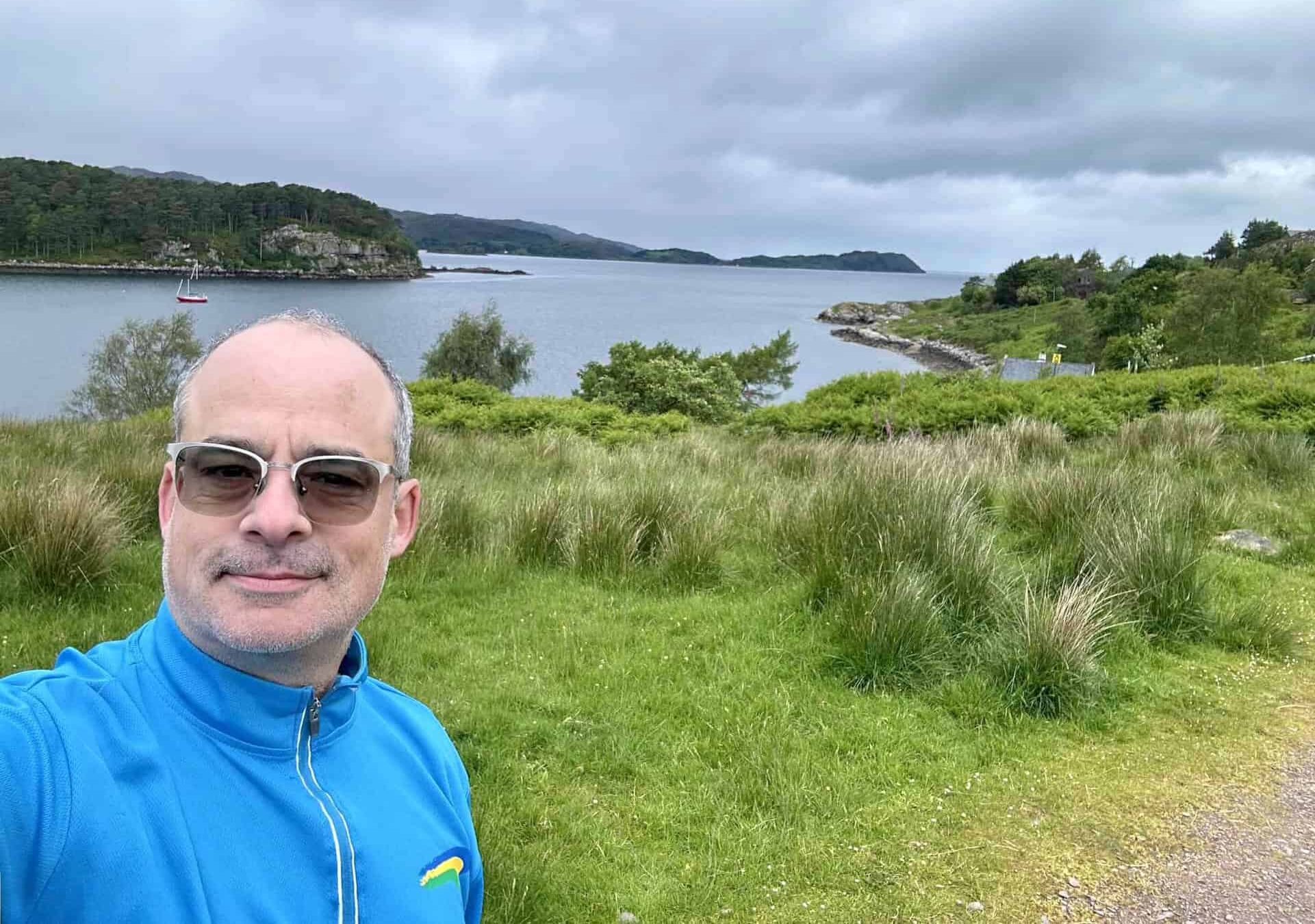
The swimmers go around the Island in the background during the swim.
I thought about how delicately balanced life needs to be to pull off doing a race like this. If one kid was sick, you needed to always have a backup. Jeez. I hoped the decongestants Levi bought would work and he wouldn’t get sick, especially during the run portion of the race the next day.
The drive to the race briefing was tedious, but uneventful. The hour long race briefing was what you would expect in Scotland, lots of dry humor and pertinent information. As the race briefing ended, I thought, well, the bike course didn’t look Starvation hard, the swim was going to be okay. I couldn’t see the run course except for the mountain section (which I likely couldn’t make the time cut off for anyway), so the race day was going to be long, beautiful, but uneventful, with no noteworthy details for my race report. How would I make this interesting? Maybe I shouldn’t write a race report at all.
While driving back to Gairloch on super rainy roads at 6:08pm
BANG. Thump thump thump.
We pulled over.
Flat tire. Shit.
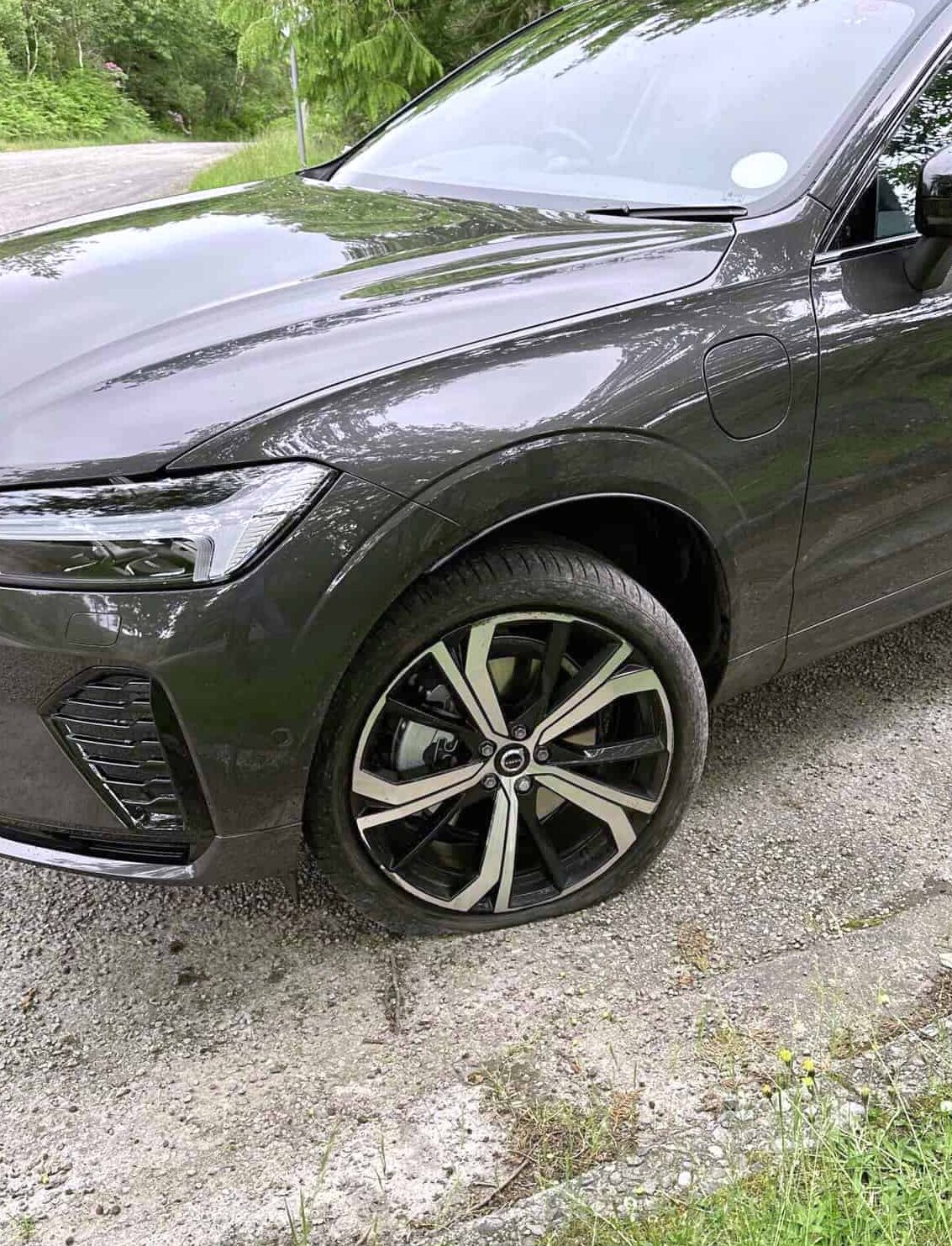
Dead tire #1
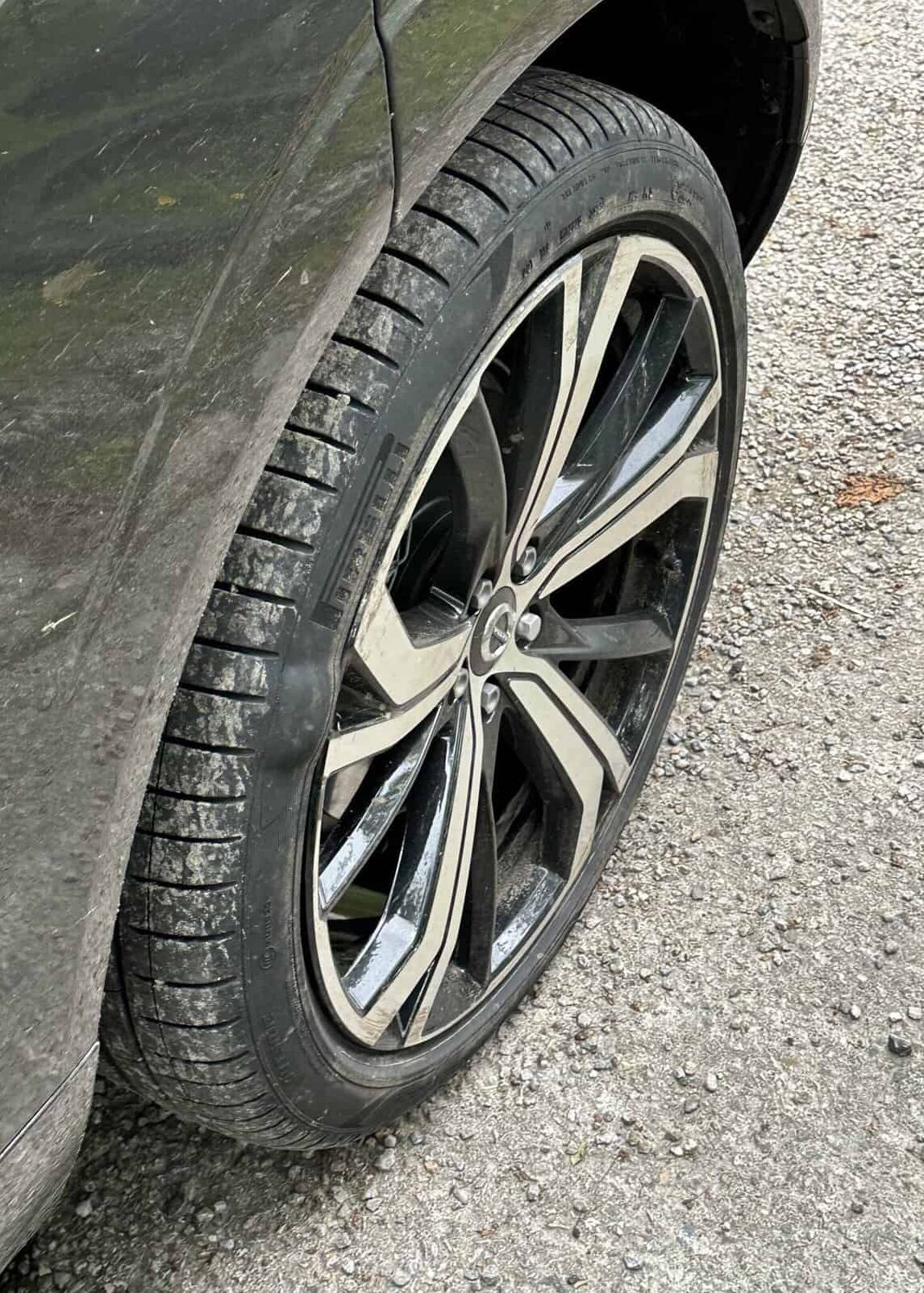
Dead tire #2. Can you see the very scary sidewall bubble?
We were on a very curvy, almost one-track road. So I drove on the bad flat tire for another half mile until I found a small parking lot next to a hydroelectric plant. I had hit a pothole and flatted the passenger side front tire. I opened the back of the Volvo x60 rental and found no spare. In addition, There was a noticeable bulge on the outside of the passenger rear tire. That can’t be good. And no cell signal. Thankfully, the car was safe and not on the road. We were 2.5 miles from our Airbnb. We couldn’t actually call for help, so Levi and I started walking. In the rain. We tried to hitchhike, but no one stopped for us. After a mile of walking, we got a cell signal so we could message Barbara and Drew. They took the other rental car and came searching for us. 20 minutes later, they found us. After we returned to Gairloch, we dialed the help number posted on the rental car windshield and learned that our phones weren’t set up for UK dialing. After we figured that out, the operator of the emergency call line said that we needed to provide her the correct tire size before she could help. The tire size numbers didn’t appear on the pictures I took of the tires before abandoning the car. Barbara drove out to the car to take more pictures. Her pictures still did not contain information on the tire size. The helpline reiterated that they could only assist us if we provided the correct tire size to determine if any contracted tire shops in the area had the tire size in their inventory. I went out to the car again. I had to move the car so the wheels turned enough to see the tire size markings. Took pictures.
After logging into T-Mobile and purchasing an unlimited UK telephone and data pass (instead of $0.25 per minute) and 45 minutes on the phone with the rental car tire help line (the operators were super pleasant and calming), they said that no car shop in the area had the tire size needed, or even two of them. Did someone need to pick me up? It might be several hours. I declined this offer around 9pm and asked if they could call Barbara the next day to arrange. I had to finish packing for my race day wake-up at 1:30am.

The gear collection before loading it into the car.
Levi went to bed at 9pm so he would have less of a chance of being sick the next day and I needed to finish all the gear arranging and load the car. Usually, I’m pretty unflappable in stressful situations. I can deal with whatever happens stoically, but the last several months of race pressure, work pressure, family pressure found an outlet in two messed up tires and a pothole in a wet single track road. And then I lost my shit.
Race packing and tire fixing rumination ended at 11pm. Fortunately, after 10 years of racing and guidance from coach Liz, I’ve learned that the crucial night for sleep is not the one before the race, but the second night before the race. I had nine hours in that bank. All we needed to do was not oversleep my two or three hours of restfulness and hope my son wasn’t sick when he woke. I still was unable to fall asleep after all was done.
Click here to read Part 2 of the 2024 Celtman! Report.
To click here to see absolutely stunning photos from the race by Ariel Wojciechowski.



Wow Ben, I’m so impressed with your race and enjoyed your blog very much!
Incredible Ben! When following a friend on a much shorter triathlon, I saw a man holding a sign: “Triathlete, A person who doesn’t understand that one sport is hard enough!!”